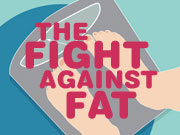The obesity epidemic
June 2, 2003
 |
| Karen Thompson of Bemidji in 1995, when she weighed nearly 400 pounds. Since then she's had two gastric bypass surgeries and lost about 225 pounds. (Photo courtesy of Karen Thompson) |
Undated — Nearly one-third of all adults are now classified as obese, according to new data from the 1999-2000 National Health and Nutrition Examination Survey.
The data show that 31 percent of adults 20 years of age and over -- nearly 59 million people -- have a body mass index (BMI) of 30 or greater, compared with 23 percent in 1994, according to the data collected and analyzed by the National Center for Health Statistics, part of the Centers for Disease Control and Prevention. The BMI is a number that shows body weight adjusted for height. BMI can be calculated with simple math using inches and pounds, or meters and kilograms. For adults, a BMI of 18.5 - 24.9 is considered normal. A BMI of 25.0 - 29.9 is overweight. If it is 30.0 and above, a person is considered obese.
Meanwhile, the percent of children who are overweight also continues to increase. Among children and teens ages 6-19, 15 percent -- almost 9 million -- are overweight. That's triple what the rate was in 1980.
 | |||
The health implications for individuals -- and for society -- are immense. Obesity increases a person's risk for a number of serious conditions, including diabetes, heart disease, stroke, high blood pressure, and some types of cancer.
A study released this spring estimated the costs of obesity and related illnesses at $78.5 billion of the nation's annual medical bills in 1998, and taxpayers paid for about half of that bill.
The study found that medical spending associated with being overweight or obese comprises 9.1 percent of U.S. spending on health care. About half of that is paid by Medicare and Medicaid, publicly-funded programs serving seniors and low-income individuals.
But while the United States spends as much money on obesity-related illnesses as on conditions related to smoking, the government has not done as much to curb obesity, the report concludes.
While we're eating more, we're exercising less. A recent government study found that one-fourth of all American adults get virtually no exercise -- either at work or on the weekends.
So how did we get into this situation? America is a land of plenty, and a land of convenience. Health experts say a variety of societal factors have combined to reduce the amount of physical activity we get in a typical day, and increase the amount of unhealthy food we eat. So people put on more weight, have a hard time losing it, and are often bombarded with confusing and conflicting information about what will work for them.
Increasingly, more obese people are turning to drastic measures, such as gastric bypass surgery, to solve the problem.
The federal government has set a goal to reduce obesity rate among adults to less than 15 percent by 2010 -- just seven years from now. Given that the trend is going in the other direction, that's a tall order. But the health of American society depends on it.
|
News Headlines
|
Related Subjects
|

